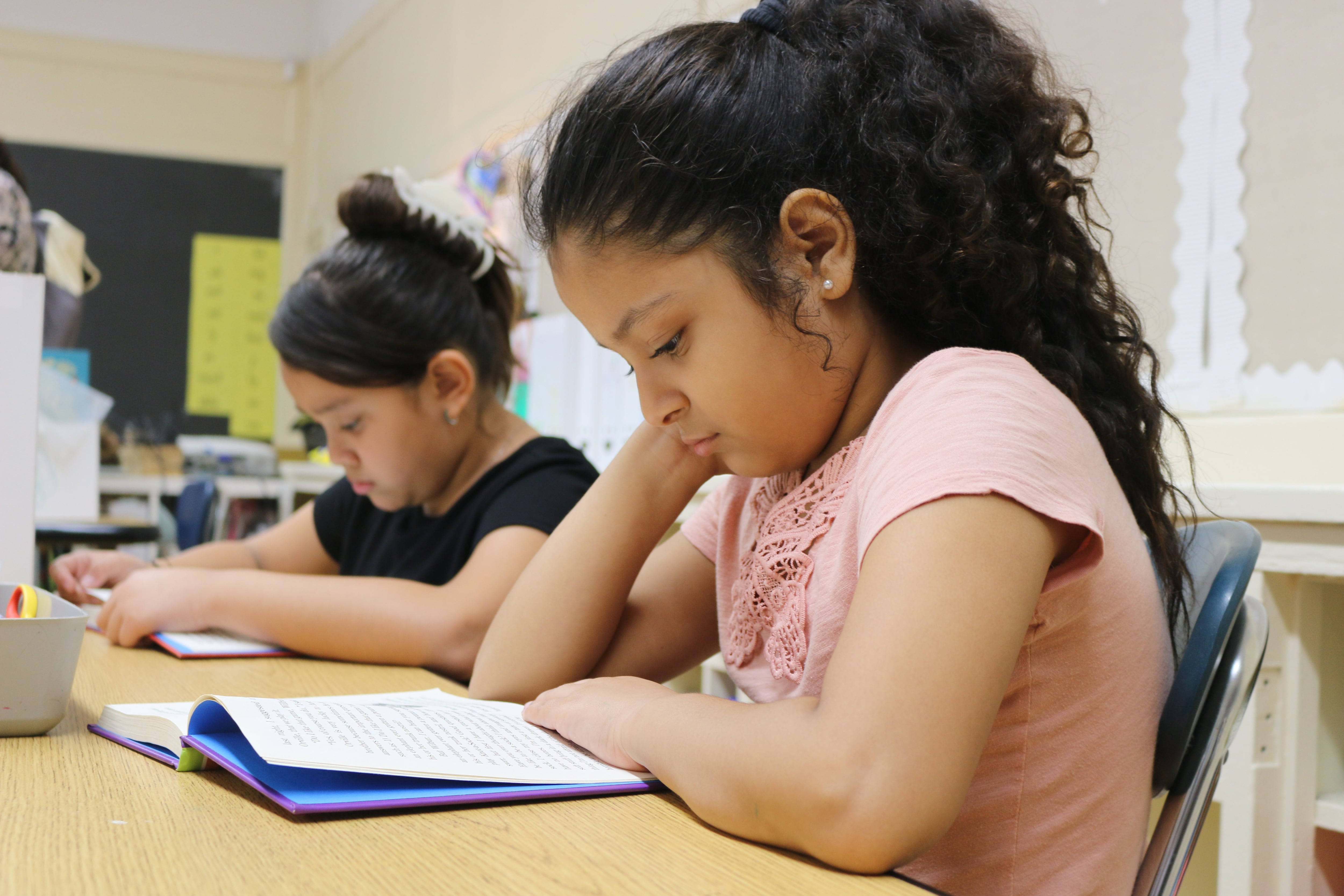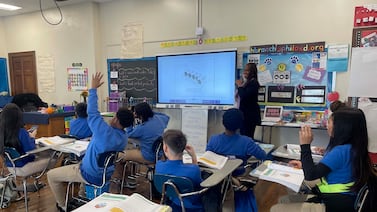Sign up for Chalkbeat’s free weekly newsletter to keep up with how education is changing across the U.S.
When schools were handed an unprecedented $129 billion in federal pandemic aid, it wasn’t surprising that COVID-related equipment topped the shopping list as schools rushed to snap up hotspots, laptops, desk dividers, and air filters.
But another widespread pattern is emerging as federal officials tally up the spending: Many districts also used their one-time funding to take care of longstanding needs, like replacing aging infrastructure and outdated textbooks, that schools previously wanted to tackle but could not afford to do so.
Around 1 in 3 school districts and charter operators nationwide, or some 5,200, used COVID relief during the 2022-23 school year to adopt new curriculum or learning materials, a report released Wednesday by the U.S. Department of Education found. That made it the most common strategy to address learning loss, which schools spent $11 billion on that year.
Schools spent some $6 billion in federal pandemic aid that same year to upgrade and maintain their facilities. That meant 1 out of every 10 COVID relief dollars spent during the 2022-23 school year went toward a school building. It was six times more than what states spent on tutoring.
And half of all COVID relief dollars schools spent that year, or just under $25 billion, were spent on staff salaries and benefits. A good chunk of that went toward paying new social workers and school nurses, which schools added to their ranks in droves with the aid.
Now that the COVID aid is mostly gone — schools have until the end of this month to spend it, unless they seek an extension — schools are confronting big questions about how they will cover curriculum overhauls and critical building repairs going forward, as well as how many of those additional staffers will lose their jobs. Many school districts, especially those with declining enrollments, are considering closing schools or cutting programs to balance their budgets.
The report looks at how the nation’s roughly 16,000 school districts and charter operators spent just over $49 billion in COVID relief dollars during the 2022-23 school year. Nearly all of the first two COVID relief packages had been exhausted and schools were halfway through spending their last and largest aid package by the end of the 2022-23 school year. Schools had spent some $117 billion in pandemic aid by that point.
Investing in people and projects with the potential for long-term payoffs made sense, federal officials say, and the Biden administration encouraged this type of spending.
Federal officials also believe provisions in the COVID aid laws that required states to maintain their own school funding will help schools return to more usual levels of funding more easily than they did following the Great Recession. When stimulus packages enacted in the wake of that financial crisis expired, many states slashed education funding and schools cut hundreds of thousands of jobs, dramatically shrinking the size of the K-12 education workforce.
“There are certainly difficult decisions that are going to get made after $130 billion is fully invested,” said Adam Schott, the principal deputy assistant secretary in the Education Department’s Office of Elementary and Secondary Education. “We are just not seeing the type of fiscal cliff that we saw 10, 12, 15 years ago.”
Part of the reason for that, Schott said, is that the Biden administration urged schools to spend the pandemic aid on both immediate needs but also long-term academic goals.
To the administration, investing in school buildings — and getting rid of issues like asbestos, mold, and lead — was also crucial.
“For decades, we’ve known that a classroom that’s 90 degrees in May or in September is an impediment to in-person learning,” Schott said. “We saw this as really core to academic recovery.”
Many schools spent on curriculum amid worrying test scores
The new data about spending on curriculum and classroom materials comes as many states and districts overhaul their approach to teaching reading and math, opting for materials that better align with the science of how children learn.
That spending also coincides with several years of national and international test score data showing that American children are academically stagnant or falling behind their earlier counterparts. That was true even before the pandemic. But the trend is especially stark for kids who score the lowest on math and reading tests.
And while recent state test scores have shown some students are rebounding to pre-pandemic levels, “We are clearly not where we ought to be,” Schott said.
Now that the federal COVID aid is gone, “states have to be ready to grab the baton,” he added, whether that’s finding new ways to spend existing federal funding, or adding money to state education budgets. “We’re going to keep beating that drum with every minute we’ve got left.”
The new federal report also comes as President-elect Donald Trump prepares to start his second term in a few days. It’s unclear how or if top education officials in his administration will push schools to continue pandemic-era programs.
On the campaign trail, Trump and his supporters said they wanted to get rid of the federal education department or shrink its powers, and give more responsibility to state officials — who already largely control what and how kids learn.
By the 2022-23 school year, most students were back to learning in person for a second school year. The pandemic was declared officially over halfway through the school year. But many students were struggling to follow the routines of school. Student absenteeism rates were still abnormally high.
Expanded summer programming was a very common investment — though it’s unclear if some of these programs helped kids improve academically. About 2 in 5 school districts or charter school operators used COVID aid on summer programs that school year, reaching around 4.5 million students.
A smaller number of districts and charter operators — around 1 in 10 nationally, or around 2,100 — used pandemic money to add instructional time. Researchers were a fan of that strategy, but educators often found it was difficult to pull off.
Meanwhile, states spent $1 billion on tutoring that school year, and districts ran intensive tutoring programs that reached some 3 million kids, or around 6% of public school students. Of those students, around half were from low-income families, while 13% were students with disabilities and 14% were learning English as a new language — suggesting that many students from historically disadvantaged backgrounds did not receive tutoring.
Earlier estimates have suggested less than 10% of students were getting tutoring thanks to COVID aid — a figure researchers have already said was likely much smaller than the share of kids who needed extra academic help after the pandemic’s disruptions to learning.
The report points out that COVID aid helped to put “more people working in America’s schools than at any time in the last decade.” As of October 2024, the report notes, schools had added some 643,000 jobs since 2021, with a 43% increase in social workers and a 23% increase in school nurses.
Some school finance experts have criticized schools for adding many new staffers or programs that they couldn’t afford to keep after the COVID aid ran out. They’ve said the hiring and firing is destabilizing, especially for schools that already had more staff turnover prior to the pandemic.
Still, Schott defended that use of the money. He pointed out that some of the added spending helped to raise low teacher pay or invest in gummed-up educator pipelines. Other spending got “more caring eyes on kids” at a chaotic time.
“You couldn’t maintain consistency for kids, you couldn’t deliver instruction, you couldn’t get core nutrition services flowing without people,” he said.
Kalyn Belsha is a senior national education reporter based in Chicago. Contact her at kbelsha@chalkbeat.org.







